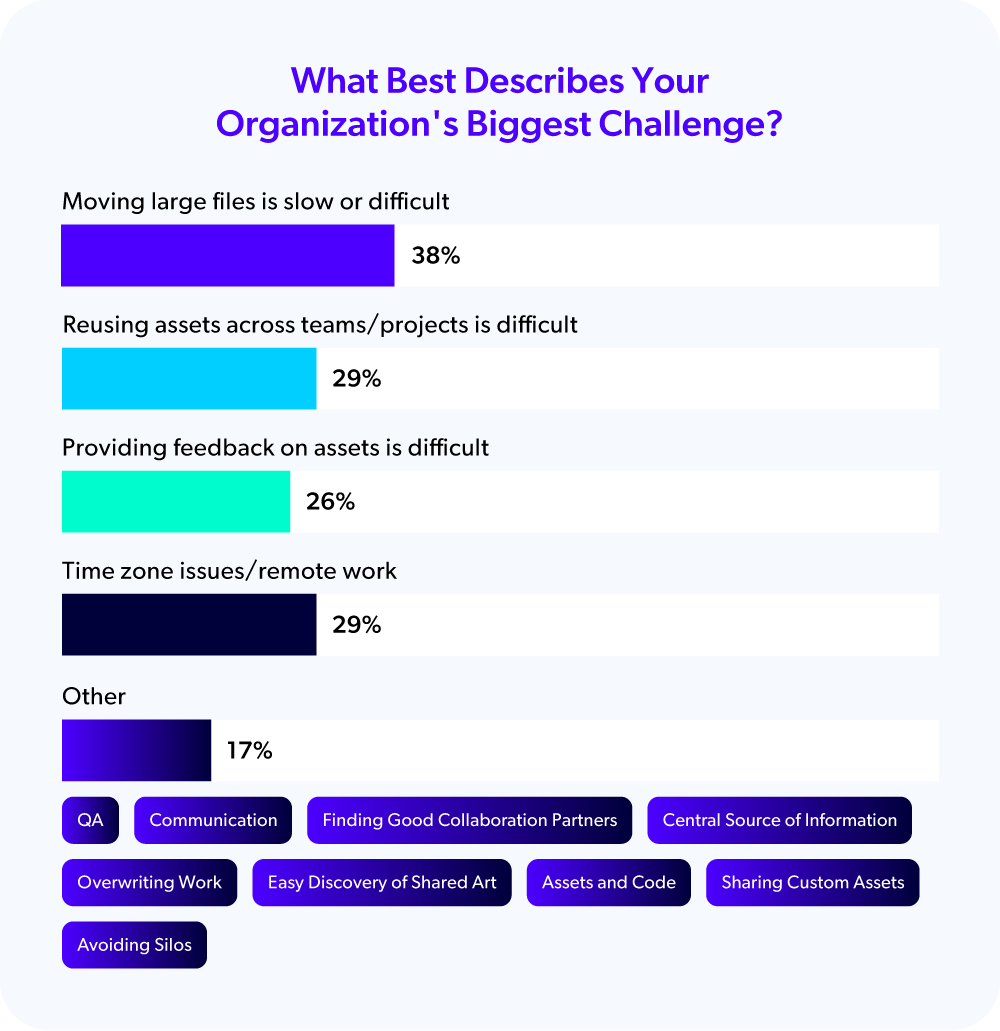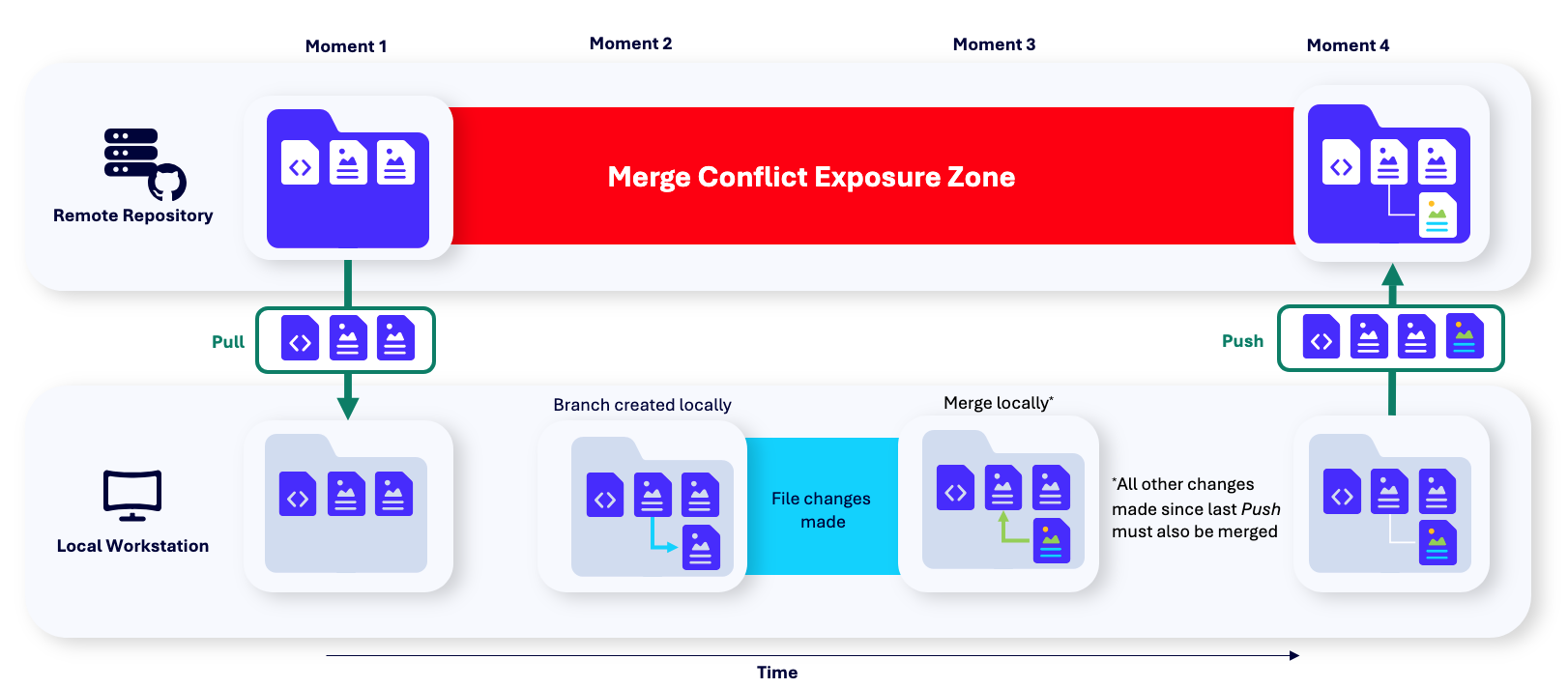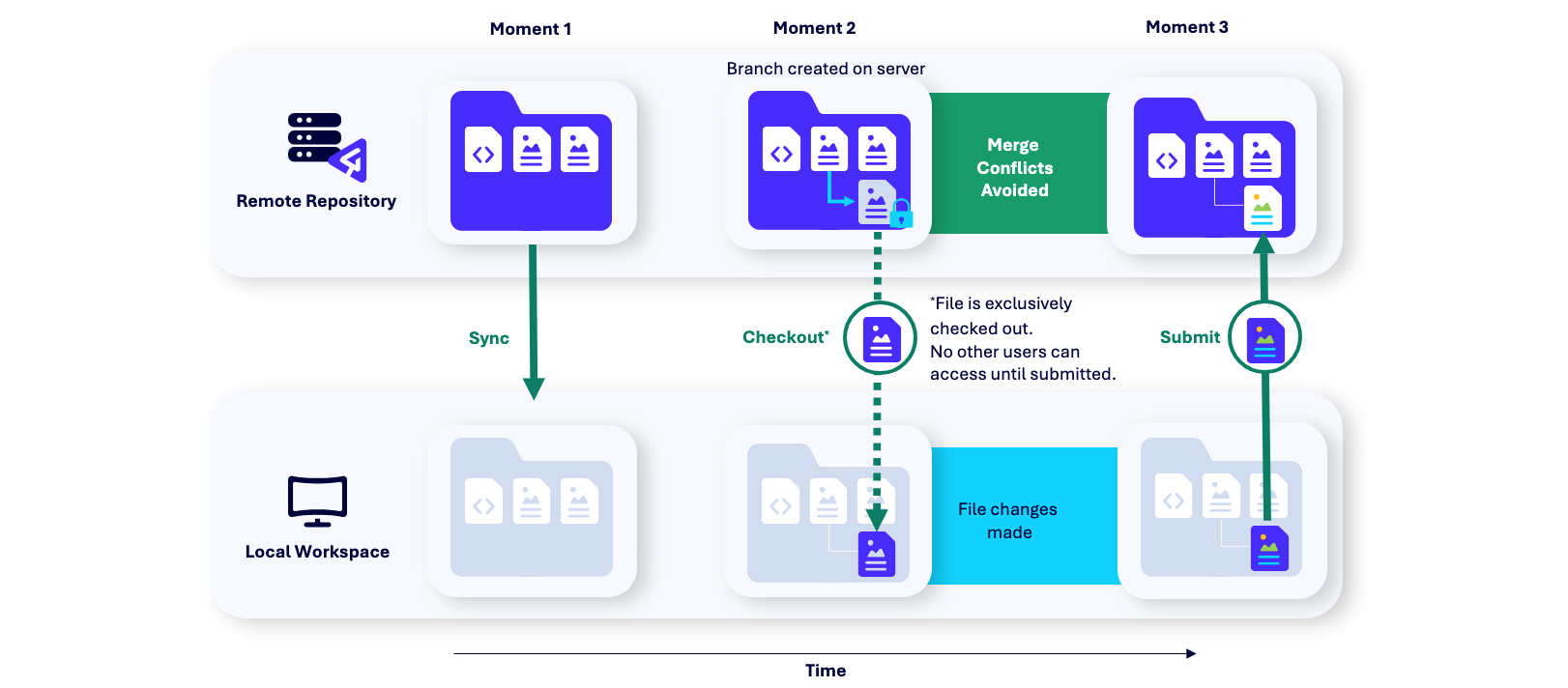Version control, also known as “source control”, is a way of tracking, managing, and safeguarding changes to digital assets over time, so teams can collaborate efficiently without losing work or overwriting changes. Version control software automates this process, making it faster, safer, and more collaborative. But its real power goes beyond simple file history. It’s how teams stay in sync, move faster, and avoid losing work, especially when the pressure's on and deadlines are looming.
What Is a Version Control System?
A version control system (VCS) maintains a history of changes to files—recording who changed what and when, as well as when files are added or deleted—over time. A version control system also allows users to easily compare versions and revert to previous states when needed. These foundational capabilities eliminate the need for manual backups or file renaming, allowing users the freedom to experiment with confidence, knowing they can revert to a previous state at any time and see what was changed at each step of development.
Unlike file sharing platforms like Google Drive or Dropbox that mostly focus on storage and basic collaboration, a version control system like Git or Perforce P4 tracks and manages changes. It also organizes team member contributions in a structured approach that can scale from individual projects to teams of varying sizes.
As projects grow in complexity and more people become involved, version control becomes increasingly valuable. It transforms from convenience into necessity, providing the organizational foundation that prevents file conflicts and enables efficient collaboration across teams and timelines.
Back to topWhy Use Version Control?
Version control isn’t just a technical tool—it’s the backbone of how modern teams stay organized, prevent errors, and deliver results. But what makes it so essential in today’s fast-paced development environments? Let’s dive into the real reasons why version control has become a must-have for teams of all sizes.
Version control software needs to do more than just manage and track files. It should help you develop and ship your projects faster. This is especially important for DevOps and CI/CD workflows where the latest versions can be tested or built automatically upon submission of a change. Version control systems can help flag and resolve potential conflicts before they enter the mainline of the project. This means the developer can fix the problem and not promote the problem further downstream.
The right version control solution serves as the foundation of modern development pipelines, keeping projects on schedule and teams in sync regardless of project size, file types, or deadline pressure.
Benefits of using the right version control software:
- Improves visibility.
- Minimizes file conflicts and wasted effort.
- Helps teams collaborate around the world.
- Accelerates product delivery.
What Happens Without Version Control?
According to the 2024 State of Game Technology Report, 38% of respondents identified "moving large files" as their biggest barrier to collaboration—more than time zone issues or remote work challenges. With modern games containing massive binary assets, this statistic clearly demonstrates why teams without proper version control struggle to maintain productivity and coordination.

The result? Costly mistakes that start at the individual level and ripple across the entire team. Without proper version control, teams are vulnerable to a range of issues, including:
- Making accidental changes that cascade through an entire project.
- Re-doing work because the correct file or version is hard to find.
- Sharing assets and information through insecure channels.
All of these issues create real financial costs and team pressure that easily multiply with each team member. For enterprise teams managing complex projects, these aren't just inconveniences—they're serious business risks that can impact product quality, time-to-market, and ultimately, revenue.
Back to top“It was the absolute worst, most dreadful feeling, opening a level, seeing every image replaced with GOLD_BEAM_06.png, all the decor, the player, the obstacles. The mistake of no proper version control was obvious to me as soon as I made it.”
Posted on Reddit
Types of Version Control Systems
As stated above, version control software keeps track of changes made to a file or set of files over time.
While the core functionality of a VCS remains consistent, the way they’re implemented can vary significantly. Depending on your team’s needs, you might choose between centralized or distributed systems. Let’s dive into the two main types of version control systems and their differences.
What types of version control systems are available for your business?
The two most common types of version control systems are centralized and distributed.
In both systems, team members download project files to their local machine from a remote repository (through a Pull command for Git-based tools, and a Sync command for Perforce P4).
In a distributed version control system (DVCS), each team member makes changes to their project files independently and commits changes locally, syncing changes to the remote repository as needed (through a Push command for Git-based tools).
In a centralized version control system (CVCS), a central server also manages access to the project files—establishing a clear source of truth all team members can reference. Users will check out files when they start modifying them, which alerts the server and other users what they are doing for better visibility. In a CVCS workflow, changes are submitted back to the remote repository (through a Submit command for Perforce P4). The central server alerts collaborators of updates to any shared project files, which the collaborator can download (through a Sync (get latest) command in Perforce P4).
Distributed Version Control (DVCS) Pros and Cons
In a distributed version control system (DVCS) like Git, developers download the entire repository to their machine. One advantage of this type of version control is that it can be quicker for users to commit changes than some centralized version control systems because the collaborator does not need to send changes back to the server until a later step.
Git vs. Perforce: Which one is best for your team? Find out in our blog here.
Problems with this model often arise when a team of developers, each working from their own copy of the repository, needs to coordinate and share changes. One user could be working on an outdated version of the repository or have unshared changes, potentially creating a big merge headache down the road. The question becomes: whose repository is the source of truth? Each developer having a copy of the repository on their machine also introduces security concerns, and containing or isolating those concerns can be difficult to manage.
Centralized Version Control (CVCS) Pros and Cons
In a centralized version control system (CVCS) like Perforce P4, all changes—including all commits and merges—are synced to the central server.
With this type of version control, users must checkout a file to work on it and make changes. The collaborator must also either submit or “shelve” changes back to the central server for other collaborators to access them.
One of the main benefits of a CVCS like Perforce P4, is the server can stop users from making conflicting changes to a file before they happen (through mechanisms like exclusive checkout for Perforce P4). A CVCS workflow greatly reduces the possibility of overwriting each other’s work, and wasting time, by making duplicative or conflicting changes to shared project files.
Some potentials problems with a CVCS model arise when the central server becomes unavailable or experiences issues. Since all users rely on a single source of truth—the central repository—any downtime can halt development entirely. Users also must coordinate carefully to avoid locking each other out or waiting on file checkouts, which can slow down collaboration. Additionally, because all changes are stored on the central server, any security breach or data loss at that location can have widespread impact, making backups and access control critical to protect the project.
Back to topHow Does Version Control Software Work?
Both DVCS and CVCS do the same job— keeping track of changes made to a file or set of files over time —but they handle it in very different ways.
When you first start working in Git, you perform what’s called a clone—downloading the entire repository (or repo), including every file and all historical changes. Whether you need one file or the whole project, you’re getting everything.
By contrast, Perforce P4 uses a centralized approach where each user creates a workspace and performs an initial sync. This sync only pulls the specific files and folders you’ve defined in your workspace.
Here’s a simple explanation of how a decentralized version control system (DVCS), like Git, works:
- A full copy of the remote repository is stored on each user’s machine, instead of relying on a single source of truth.
- Changes are committed locally to a user’s personal copy of the remote repository which cannot be viewed by other team members.
- Updates are pushed to a shared remote repository (like GitHub, GitLab, or Bitbucket) when the work is ready to be shared.
- Other users pull those updates into their own copies of the repository to stay in sync with the latest changes.
- Merge conflicts may occur when two users edit any part of the same file, requiring resolution before the merge can be complete. Merge conflicts can happen both when you push (if someone else has updated the remote repository since your last pull) and when you pull (if your local changes conflict with those updates).
- Branching is lightweight and exists locally by default, allowing developers to create, switch, and merge branches easily before pushing them to a remote.
With DVCS, everyone has a complete copy of the project. CVCS takes a different approach—one central repository that the whole team works from.
Here’s what that looks like in a CVCS, like Perforce P4:
- A central repository (in Perforce P4 this is called a depot) is created to store all files and their version history. This acts as the single source of truth for your project.
- Users sync the current files to their local workspace.
- Users check out files from the repository before they make changes. Checking out the file lets others on the team know that it is being worked on, which prevents them from overwriting the other’s changes.
- When the work is complete, changes are submitted back to the repository. Each submission creates a new version of the file, along with details about who made the change and when. Once changes are checked back in, the latest file version becomes available to the rest of the team.
- File locking may be available and used to prevent others from modifying certain files while someone is working on them — especially useful for large binary assets that can't be merged.
Both models have their place. DVCS gives you flexibility and offline control. CVCS keeps things consistent and efficient for larger teams or anyone working with binary files. Knowing the difference helps you choose the right setup for your workflow.
Branching and Merging in Version Control Software
Branching is a core concept in version control systems, allowing teams to work on parts of a project in parallel and in isolation. By creating a separate line of development—called a branch—developers can experiment, fix bugs, or build features without disrupting the stability of the main project line (often called the mainline or trunk).
See how the right branching strategy can drive faster dev cycles in this in-depth blog.
Each branch evolves independently, and eventually, the changes made in a branch may be merged back into the mainline. This merge process ensures that work from multiple contributors is integrated in a controlled way. But merging isn’t always seamless, conflicts can arise when changes overlap. That’s why a solid branching strategy is key to maintaining a stable mainline and avoiding costly rework.
Let’s take a closer look at how branching, syncing, and merging play out in two popular version control systems: Perforce P4 and Git.
Git (including GitHub, GitLab, BitBucket, etc.)
Because Git-based tools follow a DVCS workflow, branches are created locally (on an individual collaborator’s copy of the repository). After a user completes their work, they must combine changes with their local copy of the main project line (through a Merge or Rebase History command). The remote repository will be unaware of the branch, any changes, and any merges until a collaborator pushes those changes to the remote repository.
If multiple developers work on the same files, pushing changes can trigger merge conflicts. That’s why it’s critical to pull the latest updates before merging. There may also be conflicts to resolve and other changes to merge after pulling before a user can merge their new changes and push. With dozens of developers or collaborators, this process can slow things down. Cross-repository dependencies make coordination even trickier—especially as teams or repo counts grow.

Perforce P4
In P4, branches are created on the central server, giving all team members awareness of files being worked on. After a user completes their work, they can merge branches together and then submit the merged changes (through the same Submit command used to sync other types of changes).
Because team members can check out and submit individual files (not just entire repos) with Perforce P4, the need for teams to branch and any potential upstream conflicts branching can create is greatly reduced—especially for binary files.

Perforce P4 Streams
Distributed version control systems leave users to manage branching manually, often leading to confusion and complex merge logic. As discussed above, a central version control system manages branching on the server side. When discussing branching in Perforce P4, it is also important to note the distinct functionality that Streams allow.
What is a Stream?
Streams are a specialized constructs in Perforce P4 that build on familiar branching concepts. Streams are defined at a team admin level, through a Stream graph, to enforce a clear hierarchy and flow of change. Streams and branching are separate but complementary constructs.
There are several classes of Streams, many of which can function as familiar branch types (like Development or Release). However, some Streams classes (such as Virtual) allow for special import-only capabilities that can avoid the need for complex branching and file dependencies.
Streams make branching and merging less abstract and more intuitive, especially for teams with artists, designers, and developers working in parallel. Changes flow with context: merges are more predictable, conflicts are easier to track, and work stays organized.
Back to topRead more about how to get started with Perforce Streams and speed up your development in our Streams Adoption Guide.
Real-Life Version Control Examples
There are many version control systems on the market. Some are free, some are proprietary, and all have their own advantages and disadvantages. Here is a summary of some of the most popular version control tools available:
- Perforce P4, one of the leading version control examples, is a centralized version control system by Perforce Software. It’s widely regarded as the industry standard in game development, media and entertainment, and semiconductor design for its ability to handle massive projects and large teams of collaborators. P4 gives teams visibility into who is working on what, helps prevent conflicts with file-locking strategies, and is free for up to five users.
- Git is a widely popular, distributed control system for developers. Git source control is open-source and free to use. It offers easy branching and is great for small projects but it has limited security and file and repo size limits. As an open-source system, it is supported by many different companies to enable collaboration.
- Subversion (SVN) is another free, open-source version control system developed by Apache. It is a centralized version control system. It offers good concurrent development processes, but its branch and merge functions are limited, and it is not widely supported anymore.
- IBM Rational ClearCase is a software configuration management tool used for version control. It is a centralized system. This version control system is not free to use.
- Mercurial is a free, distributed version control system that was launched in 2005. It’s considered simpler than Git, but its adoption has declined, and many platforms no longer support it, making it a legacy tool.
- Unity Version Control/Plastic SCM: This version control tool was originally developed by Codice Software and is now owned by Unity. It is a distributed version control system. It is not free to use.
- Microsoft TFS (Team Foundation Server), now rebranded as Azure DevOps Server, is a version control and lifecycle management tool. Its traditional version control is centralized, though Azure DevOps also supports Git for distributed workflows. It is not free to use.
Back to top
Wondering what's the best version control for your team? Compare these top systems side-by-side here.
Getting Started with Version Control
New to version control? Our Beginner’s Guide to Perforce P4 covers everything you need to know to get started
You Can Try Perforce P4 Version Control for Free
Get all the benefits of version control software for free, for your team. Perforce P4 is free for up to 5 users — with no limits on functionality. Start small and scale, or use it for free for your small team, forever.
Using P4 helps your development team work simultaneously, automate tasks, track changes, and ensure high availability/disaster recovery.
